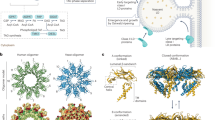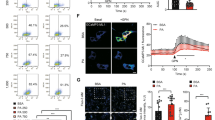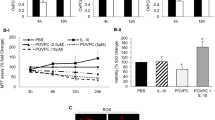Abstract
The central role of mitochondria in metabolic pathways and in cell-death mechanisms requires sophisticated signalling systems. Essential in this signalling process is an array of lipid mediators derived from polyunsaturated fatty acids. However, the molecular machinery for the production of oxygenated polyunsaturated fatty acids is localized in the cytosol and their biosynthesis has not been identified in mitochondria. Here we report that a range of diversified polyunsaturated molecular species derived from a mitochondria-specific phospholipid, cardiolipin (CL), is oxidized by the intermembrane-space haemoprotein, cytochrome c. We show that a number of oxygenated CL species undergo phospholipase A2-catalysed hydrolysis and thus generate multiple oxygenated fatty acids, including well-known lipid mediators. This represents a new biosynthetic pathway for lipid mediators. We demonstrate that this pathway, which includes the oxidation of polyunsaturated CLs and accumulation of their hydrolysis products (oxygenated linoleic, arachidonic acids and monolysocardiolipins), is activated in vivo after acute tissue injury.
This is a preview of subscription content, access via your institution
Access options
Subscribe to this journal
Receive 12 print issues and online access
$259.00 per year
only $21.58 per issue
Buy this article
- Purchase on Springer Link
- Instant access to full article PDF
Prices may be subject to local taxes which are calculated during checkout






Similar content being viewed by others
References
Murphy, M. P. Modulating mitochondrial intracellular location as a redox signal. Sci. Signaling 5, pe39 (2012).
Bozza, P. T., Bakker-Abreu, I., Navarro-Xavier, R. A. & Bandeira-Melo, C. Lipid body function in eicosanoid synthesis: an update. Prostaglandins Leukot. Essent. Fatty Acids 85, 205–213 (2011).
Gutierrez, J., Ballinger, S. W., Darley-Usmar, V. M. & Landar, A. Free radicals, mitochondria, and oxidized lipids: the emerging role in signal transduction in vascular cells. Circ. Res. 99, 924–932 (2006).
Perez-Chacon, G., Astudillo, A. M., Balgoma, D., Balboa, M. A. & Balsinde, J. Control of free arachidonic acid levels by phospholipases A2 and lysophospholipid acyltransferases. Biochim. Biophys. Acta 1791, 1103–1113 (2009).
Rouzer, C. A. & Marnett, L. J. Endocannabinoid oxygenation by cyclooxygenases, lipoxygenases, and cytochromes P450: cross-talk between the eicosanoid and endocannabinoid signaling pathways. Chem. Rev. 111, 5899–5921 (2011).
Serhan, C. N., Chiang, N. & Van Dyke, T. E. Resolving inflammation: dual anti-inflammatory and pro-resolution lipid mediators. Nature Rev. Immunol. 8, 349–361 (2008).
Stables, M. J. & Gilroy, D. W. Old and new generation lipid mediators in acute inflammation and resolution. Prog. Lipid Res. 50, 35–51 (2011).
Rice, G. E. Secretory phospholipases and membrane polishing. Placenta 19, 13–20 (1998).
Vance, J. E. & Tasseva, G. Formation and function of phosphatidylserine and phosphatidylethanolamine in mammalian cells. Biochim. Biophys. Acta 1831, 543–554 (2013).
Wright, M. M., Howe, A. G. & Zaremberg, V. Cell membranes and apoptosis: role of cardiolipin, phosphatidylcholine, and anticancer lipid analogues. Biochem. Cell Biol. 82, 18–26 (2004).
Kagan, V. E. et al. Cytochrome c acts as a cardiolipin oxygenase required for release of proapoptotic factors. Nature Chem. Biol. 1, 223–232 (2005).
Rouzer, C. A. & Marnett, L. J. Cyclooxygenases: structural and functional insights. J. Lipid Res. 50, S29–S34 (2009).
Bayir, H. et al. Selective early cardiolipin peroxidation after traumatic brain injury: an oxidative lipidomics analysis. Ann. Neurol. 62, 154–169 (2007).
Tyurin, V. A. et al. Mass-spectrometric characterization of phospholipids and their primary peroxidation products in rat cortical neurons during staurosporine-induced apoptosis. J. Neurochem. 107, 1614–1633 (2008).
Yin, H. et al. Role of mitochondria in programmed cell death mediated by arachidonic acid-derived eicosanoids. Mitochondrion 13, 209–224 (2013).
Saab-Aoude, S., Bron, A. M., Creuzot-Garcher, C. P., Bretillon, L. & Acar, N. A mouse model of in vivo chemical inhibition of retinal calcium-independent phospholipase A2 (iPLA2). Biochimie 95, 903–911 (2013).
Imig, J. D., Falck, J. R. & Inscho, E. W. Contribution of cytochrome P450 epoxygenase and hydroxylase pathways to afferent arteriolar autoregulatory responsiveness. Br. J. Pharmacol. 127, 1399–1405 (1999).
Liu, H. et al. Increased generation of cyclopentenone prostaglandins after brain ischemia and their role in aggregation of ubiquitinated proteins in neurons. Neurotoxicity Res. 24, 191–204 (2013).
Rifkind, A. B., Lee, C., Chang, T. K. & Waxman, D. J. Arachidonic acid metabolism by human cytochrome P450s 2C8, 2C9, 2E1, and 1A2: regioselective oxygenation and evidence for a role for CYP2C enzymes in arachidonic acid epoxygenation in human liver microsomes. Arch. Biochem. Biophys. 320, 380–389 (1995).
Laufer, S. A., Augustin, J., Dannhardt, G. & Kiefer, W. (6,7-diaryldihydropyrrolizin-5-yl)acetic acids, a novel class of potent dual inhibitors of both cyclooxygenase and 5-lipoxygenase. J. Med. Chem. 37, 1894–1897 (1994).
Narisawa, S. et al. Testis-specific cytochrome c-null mice produce functional sperm but undergo early testicular atrophy. Mol. Cell. Biol. 22, 5554–5562 (2002).
Vempati, U. D. et al. Role of cytochrome c in apoptosis: increased sensitivity to tumor necrosis factor alpha is associated with respiratory defects but not with lack of cytochrome c release. Mol. Cell. Biol. 27, 1771–1783 (2007).
Vempati, U. D., Han, X. & Moraes, C. T. Lack of cytochrome c in mouse fibroblasts disrupts assembly/stability of respiratory complexes I and IV. J. Biol. Chem. 284, 4383–4391 (2009).
Li, K. et al. Cytochrome c deficiency causes embryonic lethality and attenuates stress-induced apoptosis. Cell 101, 389–399 (2000).
Moon, S. H. et al. Activation of mitochondrial calcium-independent phospholipase A2g (iPLA2g) by divalent cations mediating arachidonate release and production of downstream eicosanoids. J. Biol. Chem. 287, 14880–14895 (2012).
Krysko, D. V. et al. Emerging role of damage-associated molecular patterns derived from mitochondria in inflammation. Trends Immunol. 32, 157–164 (2011).
Wilensky, R. L. et al. Inhibition of lipoprotein-associated phospholipase A2 reduces complex coronary atherosclerotic plaque development. Nature Med. 14, 1059–1066 (2008).
Tyurin, V. A. et al. Specificity of lipoprotein-associated phospholipase A2 toward oxidized phosphatidylserines: liquid chromatography–electrospray ionization mass spectrometry characterization of products and computer modeling of interactions. Biochemistry 51, 9736–9750 (2012).
David, S., Greenhalgh, A. D. & Lopez-Vales, R. Role of phospholipase A2s and lipid mediators in secondary damage after spinal cord injury. Cell Tissue Res. 349, 249–267 (2012).
Dennis, E. A., Cao, J., Hsu, Y. H., Magrioti, V. & Kokotos, G. Phospholipase A2 enzymes: physical structure, biological function, disease implication, chemical inhibition, and therapeutic intervention. Chem. Rev. 111, 6130–6185 (2011).
Daum, G., Lees, N. D., Bard, M. & Dickson, R. Biochemistry, cell biology and molecular biology of lipids of Saccharomyces cerevisiae. Yeast 14, 1471–1510 (1998).
Kagan, V. E. et al. Cytochrome c/cardiolipin relations in mitochondria: a kiss of death. Free Radic. Biol. Med. 46, 1439–1453 (2009).
Basova, L. V. et al. Cardiolipin switch in mitochondria: shutting off the reduction of cytochrome c and turning on the peroxidase activity. Biochemistry 46, 3423–3434 (2007).
Belikova, N. A. et al. Peroxidase activity and structural transitions of cytochrome c bound to cardiolipin-containing membranes. Biochemistry 45, 4998–5009 (2006).
Belikova, N. A. et al. Heterolytic reduction of fatty acid hydroperoxides by cytochrome c/cardiolipin complexes: antioxidant function in mitochondria. J. Am. Chem. Soc. 131, 11288–11289 (2009).
Kim, I. C. Radioimmunoassay for testicular cytochrome c (ct). Evidence for the presence of apocytochrome ct pool in rat testis extract. J. Biol. Chem. 262, 11156–11162 (1987).
Schug, Z. T. & Gottlieb, E. Cardiolipin acts as a mitochondrial signalling platform to launch apoptosis. Biochim. Biophys. Acta 1788, 2022–2031 (2009).
Arnarez, C., Marrink, S. J. & Periole, X. Identification of cardiolipin binding sites on cytochrome c oxidase at the entrance of proton channels. Sci. Rep. 3, 1263 (2013).
Liu, Z. et al. Remarkably high activities of testicular cytochrome c in destroying reactive oxygen species and in triggering apoptosis. Proc. Natl Acad. Sci. USA 103, 8965–8970 (2006).
Kiebish, M. A. et al. Dysfunctional cardiac mitochondrial bioenergetic, lipidomic, and signaling in a murine model of Barth syndrome. J. Lipid Res. 54, 1312–1325 (2013).
Davis, B. et al. Electrospray ionization mass spectrometry identifies substrates and products of lipoprotein-associated phospholipase A2 in oxidized human low density lipoprotein. J. Biol. Chem. 283, 6428–6437 (2008).
Chu, C. T. et al. Cardiolipin externalization to the outer mitochondrial membrane acts as an elimination signal for mitophagy in neuronal cells. Nature Cell Biol. 15, 1197–1205 (2013).
Garg, A. D. et al. Immunogenic cell death, DAMPs and anticancer therapeutics: an emerging amalgamation. Biochim. Biophys. Acta 1805, 53–71 (2010).
Ray, N. B. et al. Dynamic regulation of cardiolipin by the lipid pump Atp8b1 determines the severity of lung injury in experimental pneumonia. Nature Med. 16, 1120–1127 (2010).
Codina, R., Vanasse, A., Kelekar, A., Vezys, V. & Jemmerson, R. Cytochrome c-induced lymphocyte death from the outside in: inhibition by serum leucine-rich α-2-glycoprotein-1. Apoptosis 15, 139–152 (2010).
Xu, L., Davis, T. A. & Porter, N. A. Rate constants for peroxidation of polyunsaturated fatty acids and sterols in solution and in liposomes. J. Am. Chem. Soc. 131, 13037–13044 (2009).
Cheng, H. et al. Shotgun lipidomics reveals the temporally dependent, highly diversified cardiolipin profile in the mammalian brain: temporally coordinated postnatal diversification of cardiolipin molecular species with neuronal remodeling. Biochemistry 47, 5869–5880 (2008).
Ji, J. et al. Lipidomics identifies cardiolipin oxidation as a mitochondrial target for redox therapy of brain injury. Nature Neurosci. 15, 1407–1413 (2012).
Tyurina, Y. Y. et al. Oxidative lipidomics of gamma-radiation-induced lung injury: mass spectrometric characterization of cardiolipin and phosphatidylserine peroxidation. Radiation Res. 175, 610–621 (2011).
Rouser, G., Fkeischer, S. & Yamamoto, A. Two dimensional then layer chromatographic separation of polar lipids and determination of phospholipids by phosphorus analysis of spots. Lipids 5, 494–496 (1970).
Miller, T. M. et al. Rapid, simultaneous quantitation of mono and dioxygenated metabolites of arachidonic acid in human CSF and rat brain. J. Chromatogr. B 877, 3991–4000 (2009).
Acknowledgements
We are thankful to J. L. Millan and S. Narisawa for providing the t-cyt c-specific antibody. We acknowledge support from the National Institutes of Health (ES020693, ES021068, U19AIO68021, PO1 HL114453, NS076511, NS061817, NS052315), the National Institute for Occupational Safety and Health (OH008282), the National Center for Research Resources (S10RR023461), the Human Frontier Science Program (HFSP-RGP0013/2014) and the Fulbright US/Canada Scholar Program.
Author information
Authors and Affiliations
Contributions
Y.Y.T. designed experiments, performed the MS analysis of CL and its oxidation and hydrolysis products in vivo and in vitro and co-wrote the manuscript, S.M.P. performed MS analysis of oxygenated species of arachidonic acid, V.A.T. performed experiments on CL hydrolysis by LpPLA2 and MS analysis of CL and its hydrolysis products in the small intestine and cells, A.A.K. performed experiments on peroxidase activity of cyt c/CL complexes, J.J. performed the experiments on knocking down t-cyt c, T.S.A. and V.I.K. participated in the MS analysis of CL and its oxidation and hydrolysis products, A.S.V. and M-Y.J. performed cell and mitochondria experiments, D.M. and J.K.S. performed computational analysis of s-cyt c and t-cyt c, M.W.E. and J.S.G. contributed to the design and performance of the in vivo experiment (WBI), T.C.J. and P.M.K. participated in the design and performance of the in vitro experiments with neurons and astrocytes, Y.A.V. and B.R.P. participated in discussion of the results on LC/MS and aspects of the work with the hydrolysis of CLox, H.B. contributed to the formulation of the initial concept of the study, designed and participated in the performance of the in vivo experiment (CCI) and co-wrote the manuscript, and V.E.K. suggested the idea, designed the study and wrote the manuscript. All authors discussed the results and commented on the manuscript.
Corresponding authors
Ethics declarations
Competing interests
The authors declare no competing financial interests.
Supplementary information
Supplementary information
Supplementary information (PDF 1209 kb)
Rights and permissions
About this article
Cite this article
Tyurina, Y., Poloyac, S., Tyurin, V. et al. A mitochondrial pathway for biosynthesis of lipid mediators. Nature Chem 6, 542–552 (2014). https://doi.org/10.1038/nchem.1924
Received:
Accepted:
Published:
Issue Date:
DOI: https://doi.org/10.1038/nchem.1924
This article is cited by
-
Principles and functions of metabolic compartmentalization
Nature Metabolism (2022)
-
Omega-3 and omega-6 fatty acid differentially impact cardiolipin remodeling in activated macrophage
Lipids in Health and Disease (2018)
-
FINO2 initiates ferroptosis through GPX4 inactivation and iron oxidation
Nature Chemical Biology (2018)
-
Effect of high fat diet on phenotype, brain transcriptome and lipidome in Alzheimer’s model mice
Scientific Reports (2017)
-
The mito-DAMP cardiolipin blocks IL-10 production causing persistent inflammation during bacterial pneumonia
Nature Communications (2017)



